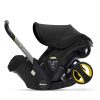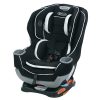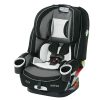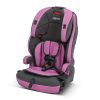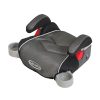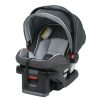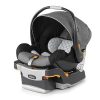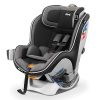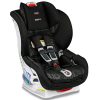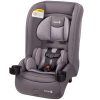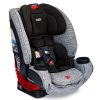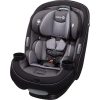If you’re looking for something on the car seat weight and height limits, here is the ultimate guide.
We will try our best to explain the car seat weight limits for infant, convertible, and booster seats, and of course the height limits.
However, the top weight and height limits for car seats and the weight range might vary a lot based on the types, or even models. So we’ll list some top-rated car seats with their weight and height limits.
One of the most important things you should check before buying a car seat is your child’s weight and height.
You should make sure they don’t exceed the height and weight limits of their car seats, no matter what types of car seats are used, rear-facing, forward-facing, or booster.
From birth to youth, a child will ride in a car seat going through four stages with each stage lasting for several years.
The bounding between each stage is not fixed, the child’s age, weight, and height are the leading factors to decide which car seat is good for the littles.
The car seat laws in the most of 50 US states may ask you to use the carseat by following the manufacturer’s instructions. So it’s important to know the weight limit for the infant car seats, convertible car seats, and booster seats.
The manufacturers also emphasize the child’s weight and height requirements to use their car seats in the car seat user manual and product description.
So we want to talk about the height and weight limits of each stage and every type of car seat, hoping these tips will help you find the best car seats to fit your growing child.
Rear-Facing
Height and Weight Limit for Fear Facing Car Seats
Forward-Facing
Height and Weight Limit for Front Facing Car Seats
Booster
Height and Weight Limits for Booster Seats
Rear-Facing
Rear-Facing Car Seats Weight and Height Limits
Forward-Facing
Forward-Facing Car Seat Weight and Height Limits
Height and Weight Limit for Car Seats
The basic guideline to choose the right child safety seat is to make sure your child’s height and weight do NOT exceed the car seat weight and height limits.
The height and weight limits vary depending on the car seat types, but the weight range of each car seat type is very similar.
Car Seat Weight Limit
It commonly refers to the minimum and maximum weights that a car seat can fit. Each type of car seat may come with a similar weight limit range.
Infant car seats are typically designed for babies between 4 ~5 lbs to 30~35 lbs.
Convertible car seats are suitable for newborns between 4~5 to 40~50 pounds in rear-facing and toddlers between 20~25 pounds to 65 pounds in front-facing.
Booster seats are good for big kids weighing from 40 pounds to 100~120 pounds.
Car Seat Height Limit
It’s the maximum height that a car seat can hold.
The vast majority of children will be too tall for their rear-facing car seat before reaching the seat’s maximum weight limit.
So it’s better to check your little one’s height more often than the weight to know when to move them from rear-facing to forward-facing and to a booster.
Each type of car seat also has a similar upper height limit range.
Infant car seats are designed with a top height limit under 30~32 inches.
Convertible car seats are good to accommodate toddlers under 49~54 inches tall.
Booster seats are suitable for big kids below 57~63 inches.
The minimum height limit is normally forgotten because it’s much easier for kids to exceed this guideline during their growth.
Rear-Facing Car Seat Weight Limit and Height Limit
Each car seat has its own minimum and maximum limits so check your car seat’s instruction manual before using the seat.
Infant Car Seat Weight Limit: 30-35 lbs
Infant car seats are rear-facing only. They are designed for newborns, babies, and small toddlers under 1 year old. However, the littles usually outgrow the height or weight limits of their infant car seats before their first birthday.
Most infant car seats come with a weight limit between 30 pounds and 35 pounds, depending on specific models. For example, the Chicco KeyFit 30 is designed for 30 pounds littles, while the Graco SnugRide SnugLock 35 is for 35 pounds infants.
Very few infant carseat like the Maxi Cosi Coral XP has a lower weight limit of as low as 22 pounds. However, it’s the most innovative and lightest infant car seat.
It’s common that tall babies exceed the 35-pound weight limit, which happens at 12 months or 6 months for those who grow a bit faster than their peers.
Infant Car Seat Height Limit: 30-32 inches
The average weight limit for infant car seats range from 30 inches to 32 inches, depending on specific models. The majority of the infant car seats have a 32-inch height limit. And it’s trendy that more and more infant car seats will feature this max height to fit growing babies.
There is very few exception as far as I know. Maxi Cosi Coral XP is 29-inch.
Most Reviewed Infant Car Seats
Convertible Car Seat Weight Limit in Rear Facing
Convertible car seats can be used in rear- and forward-facing. When in the rear-facing mode, they can accommodate newborns between 4~5 to 40~50 pounds, according to different models.
For example, Graco Extend2Fit comes with a low weight limit of 4 pounds and a top weight limit of 50 pounds, making it one of our best recommendations for keeping babies rear-facing for a longer period of time.
Convertible Car Seat Height Limit in Rear Facing
The height limits of convertible car seats in rear-facing mode vary depending on the models but are typically in the range of 40-inch to 49-inch. The Graco Extend2Fit allows for infants 49-inch tall, but it uses an extended panel for big toddlers, while the Chicco NextFit Zip performs the best in rear-facing height limit – up to 43 inches, making it a good rear-facing car seat for tall babies.
Further Information
Most Reviewed Convertible Car Seats
All-in-one Car Seat Weight and Height Limits for Rear-Facing
All-in-one (3-in-1 or 4-in-1) car seats can be used as an infant, convertible, and booster in both rear- and front-facing. When rear-facing as an infant car seat, they are able to ride newborns between 4~5 to 40~50 pounds. Taking the most popular Graco 4Ever DLX 4-in-1 car seat, for example, it is designed with a 4-pound minimum weight and 40-pound maximum weight. The Radian 3R comes with weight limits of 5 and 50 pounds.
The majority of the all-in-one car seats are designed with a maximum height of 49-inch, which is good for fitting growing infants.
Further Information
Most Reviewed All-in-one Car Seats
Forward-Facing Car Seat Weight Limit and Max Height
As your child grows closer to the weight or height limit of their rear-facing car seats, it’s time to switch to a forward-facing car seat. This happens when they’re 2 years or 3 years old.
Weight to Face Forward in Car Seat
22-pound is the most commonly seen minimum weight requirement to face forward in a car seat, no matter what types of car seat you’re using for your child, convertible, all-in-one, or combination.
A few other options are available with a lower weight to face forward in a car seat, the convertibles from Britax, which stated in their description that 20 pounds are the minimum weight requirement for forward-facing.
Convertible Car Seat Weight and Height Limits - Forward Facing
When used in front-facing mode, the convertible car seats are able to accommodate toddlers between 20~22 pounds to 65 pounds, along with a low height limit of 28-inch and a top height limit of 49-53 inches.
The majority of convertible car seats are designed with low and top weight limits between 22-65 pounds with a maximum height up to 49-inch tall. The Britax’s convertible car seats and Orbit G5 toddler car seat are exceptional. Convertible car seats manufactured by Britax come with a less low weight limit of 20 pounds, while the Orbit G5 comes with a higher maximum height of 53-inch.
All-in-one Car Seat Weight and Height Limits - Forward Facing
When using the all-in-one car seats with the harness, their weight and height limits are very close to the convertible car seats’, between 22-65 pounds in weight and 29-49 inches in height, depending on the models.
Combination Car Seat Weight and Height Limits
The combination car seats (harness booster seats) can be used forward-facing only for big kids at least 22 pounds. When being used with a harness, the weight and height limits are ranged from 22-65 pounds and 29-54 inches.
The KidsEmbrace SpiderMan 2-in-1 harness booster is designed with minimum and maximum weights of 22 and 65 pounds, along with height limits of 29 and 49 inches, while the Chicco MyFit harness booster comes with minimum and maximum weights of 25 and 65 pounds, and height limits of 29 and 54 inches.
Booster Seat Weight and Height Requirements
Booster seats are designed for big kids whose weight or height exceeds the forward-facing limit for their car safety seat. The booster seats are generally installed with the vehicle’s lap and shoulder belt, so they’re also called belt-positioning boosters.
It’s the last stage that your child needs a car seat until they are old enough and large enough with the vehicle seat belt that fits properly.
High back booster seat requirements
No matter a high back booster, or all-in-one car seat used in booster mode, or a harness booster in booster mode, the lowest weight for a child to ride in this stage must be at least 40 pounds. The top weight limit of booster seat varies in the range of 100~120 pounds based on the models.
The height limits of all those three types of high back booster seats may vary a lot based on the real-life models, but still in the range of 38~63 inches. For example, the Graco 4Ever DLX 4-in-1 car seat is able to ride children between 43-57 inches tall, while the Diono Cambria 2 car seat is good for kids up to 63 inches tall.
Besides the weight and height limits, the car seat laws in the US also require a child to be at least 4 years old to use a booster seat. That’s the basic age requirement in the US states.
Backless booster seat requirements
Backless booster seats generally have the same requirements in child’s age, weight, and height as the high back boosters. After all, they are in the same stage.
Some cases are exceptional. A few all-in-one car seats have a higher weight limit in the backless mode than in the high back mode. The Graco’s 4Ever DLX and Grows4Me are two 4-in-1 car seats with a higher weight limit. The former supports 120 pounds in backless mode, compared to its 100 pounds top weight limit in high back mode. The latter allows for a 110 pounds backless weight limit compared to its 100 pounds high back weight limit.
Same as the high back boosters, it also required a child to be at least 4 years old to ride in the backless booster seats.
These are a common age, weight, and height limits of car seats at every stage. However, each state has its own requirements and laws for parents to ride a child in a vehicle. You should always check your local laws before taking your child traveling on the road. We have listed a brief introduction to all US states laws for child safety seats for your reference.
When to Switch the Car Seat?
That’s one of the most important questions a lot of parents may ask. Even seasoned parents may also be fuzzy on the right car seat type and when it’s the right time for a change.
Pediatricians should be prepared to provide advice at every health maintenance visit to ensure that children are as safe as possible. The evidence-based recommendations call for the following:
- Children should ride in a rear-facing car safety seat as long as possible until they approach the highest weight or height allowed by the car seat manufacturer. Most convertible seats and all-in-one car seats have limits that will allow riding children rear-facing even at their 2nd birthday or older.
- Once they have outgrown the rear-facing weight or height limit, it’s time to turn around to front-facing. Children should stay in a forward-facing car safety seat with a harness for as long as possible, up to the seat’s weight and length limits. Most car seats can fit children up to 65 pounds or more.
- When they exceed the highest weight or height that allows for their car seats in a forward-facing harness, children should use a belt-positioning booster seat until the vehicle lap and shoulder seat belt fits properly.
- Once they outgrow the booster limits and are large enough to use the vehicle seat belt alone, they should always use lap and shoulder seat belts, typically when they have reached 4 feet 9 inches in height and are 8 to 12 years of age.
- All children younger than 13 years should be restrained in the rear seats of vehicles for optimal protection.
FAQs of Car Seats Height and Weight Limits
What is the weight limit for car seats?
That depends. The weight limit for car seats vary depending on the car seat types and how to use the car seat itself.
Even in the same type, the weight limit for car seat is different from others.
Infant car seat weight limits fall between 30 and 35 pounds. Chicco KeyFit 30 – 30 pounds and Doona Infant Car Seat Stroller -35 pounds.
Convertible car seat weight limits for forward-facing use are quite stable at 65 pounds and 49 inches. The rear-facing weight limit may vary on models, but within a range. For instance, 40-50 pounds for top weight limit are commonly seen in convertible car seats and the 40″-49″ are the most usual top height limit for using a convertible car seat in rear-facing mode.
What is the weight limit on infant car seats
The top weight limit on infant car seats are within this range: 30-35 pounds.
What kind of car seat should a 40 lb child be in?
A child weighing 40 pounds can stay in convertible car seats, all-in-one car seats, harness boosters, and booster seats.
The first three types of car seats support riding the 40 lb child with a harness and they are safer than booster seats, which have more requirements than the 40 lb lowest weight limit. Your child should also be at least 4 years old to ride in a booster. Only use a booster when your child meets the minimum age and weight or height limits.
How much does your kid have to weigh for a booster seat?
A child has to weigh at least 40 pounds to use a booster. More than the minimum weight, he or she is also required to be at least 4 years old. They are allowed to ride in a booster meeting both conditions.
When can a child go into a booster seat?
A child can go into a booster when he or she weighs at least 40 pounds and is at least 4 years old. But you don’t need to move them to a booster seat in a rush. You should stick with the current stage with a 5-point harness until your child exceeds the highest height or weight of their forward-facing harnessed seats.
Should You Move Your Toddler to a Booster Seat
That depends. It’s okay to move a toddler to a booster seat when they meet these two requirements: 4 years old or older and 40 pounds or more. However, it’s recommended to keep the toddlers in a forward-facing harness for as long as possible.
How do you know if your child is too tall for a car seat?
The direct way is to check the car seat’s height limits and measure your child’s height to see if your child is too tall for a car seat or not. If their height is equal to or higher than the height limit, they’re too tall for the car seat. Otherwise, the car seat still fits safely for riding them.
What weight to ride a front facing car seat ?
That depends. Generally, convertible, combination, and all-in-one car seats are able to ride a 22-pound child in a front facing, except the Britax convertibles of 20 pounds.
Booster seats require a higher minimum weight for a child to face forward, your child should be at least 40 pounds.
Sources
NHTSA for car seat requirements.

